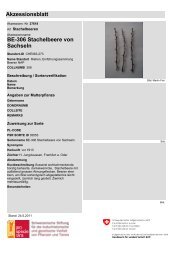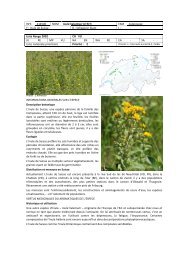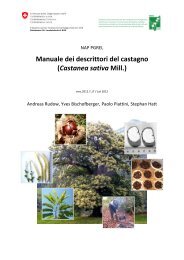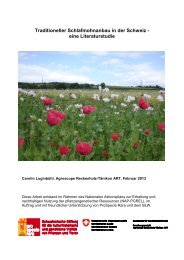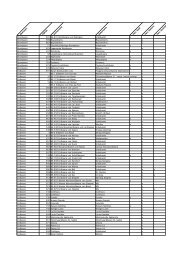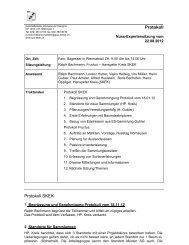Schlussbericht Crop Wild Relative
Schlussbericht Crop Wild Relative
Schlussbericht Crop Wild Relative
- TAGS
- schlussbericht
- crop
- wild
- relative
- bdn.ch
Sie wollen auch ein ePaper? Erhöhen Sie die Reichweite Ihrer Titel.
YUMPU macht aus Druck-PDFs automatisch weboptimierte ePaper, die Google liebt.
Distribution of Linum dolomiticum in the Carpathian Basin<br />
Distribution<br />
An endemic and relic plant species of the Hungarian<br />
flora, it can be found only on one<br />
location (Kisszénás) in the entire world, in close<br />
proximity to the Buda Landscape Protection<br />
Area. The world population is living on a 10<br />
hectare size habitat which is strictly protected.<br />
Ecology<br />
The Budapest part of the Buda Landscape<br />
Protection Area managed by Directorate of<br />
the Danube–Ipoly National Park is<br />
characterized by the richness of plant<br />
communities. The limestone and dolomite rock<br />
grasslands, covered only with a thin layer of<br />
ground, have the highest diversity, and are<br />
home to the most rare species. Endemic to the<br />
Carpathian basin are Draba lasiocarpa Rochel<br />
var. demissorum Borbás, Phyteuma orbiculare<br />
L., Seseli leucospermum Waldst. et Kit., Dianthus<br />
plumarius L. ssp. regis-stephani (Rapcs.) Baksay,<br />
Centaurea sadleriana Janka, or Vincetoxicum<br />
pannonicum (Borhidi) Holub. The latter can be<br />
found only in the Villányi Mountains and here.<br />
Facing north, on the cooler slopes grows<br />
Sesleria sadleriana Janka.<br />
Threats<br />
The most important threats to L. dolomiticum<br />
are disturbances and its small population size.<br />
At present, its level of threat is assessed as low.<br />
References<br />
In situ conservation<br />
First steps to protect this endemic flax species<br />
were taken in 1934. This species is protected by<br />
Law № LIII. of 1996 on Nature Conservation and<br />
Act № 13/2001 of the Ministry of Environmental<br />
Protection. In addition it is listed in the Bern<br />
Convention 1979, CORINE Biotopes and the<br />
Habitats Directive (92/43/EEC) Appendix l. and<br />
European Diploma 1995 (The Szénás Hills strictly<br />
protected area).<br />
Ex situ conservation<br />
Three seed samples from three populations are<br />
conserved in the genebank collection at the<br />
Institute for Agrobotany, Tápiószele (Hungary).<br />
Dobolyi, K. (2002): A Linum dolomiticum Borbás monitorozása. [Monitoring of Linum dolomiticum Borbás] — I. Magyar<br />
Természetvédelmi Biológiai Konferencia, Sopron 2002. november 14–17.<br />
Dobolyi, K. (2003): Study of the population of the endemic Linum dolomiticum Borbás (Hungary). — IXth Congress of the<br />
European Society for Evolutionary Biology, Leeds, UK, 18–24 August 2003.<br />
Dobolyi, K. (2003): Phytosociological evaluation and multivariate analysis of the habitat of Linum dolomiticum Borbás<br />
(Linaceae) I. — Studia bot. hung. 34: 111–120.<br />
www.pgrforum.org<br />
1 km<br />
Locations of the existing populations of L. dolomiticum<br />
in the Buda Hills



